Background:
Soil pollution occurs when a soil becomes enriched in a contaminant exceeding the naturally existing level or contains a contaminant that poses a threat to living systems and soil health.1-3 Pollutants can come from point sources--leaking pipes, smoke stacks, or spills--or non-point sources such as vehicle exhaust or pesticide drift.4 Pollutants may be organic, compounds containing covalently bound carbon, such as oil, pesticides, and pharmaceutical and personal care products, among others; or inorganic, often metals.5-6 While many of these pollutants come from human activity, some are present in soils due to natural processes or local geology.1-2, 6-7 Regardless of source, soil pollution is a significant problem which harms natural systems, crop production, and human health.8 Management strategies that may work to increase the rate of organic pollutant breakdown or decrease the bioavailability of inorganic pollutants are 1) increasing soil organic matter, 2) raising soil pH, 3) reducing contact with contaminated soil, and 4) biostimulation.

Oil spill in Kansas. By Leif Skoogfors https://www.fema.gov/media-library/assets/images/51499 (public domain)
Diagnosis:
The consequences of soil pollution are often visible, such as when crops die off or fish are killed in surrounding waterways, however identification of specific pollutants is challenging, frequently requiring soil testing and chemical analyses.

New Idria mercury polluted water. By Joe.nehls https://en.wikipedia.org/w/index.php?curid=43597534
Management:
Below is a short summary of various management practices. For a full list of additional resources click here. Additional testing is needed to determine if management has led to successful contaminant remediation.
Increasing soil organic matter
Increased soil organic matter can reduce pollutant bioavailability to plants and may facilitate biodegradation of organic pollutants, reducing symptoms of toxicity.
- Compost and manure application increases both soil fertility and soil organic matter.
- Cover cropping can prevent erosive transport of contaminated soils, increases SOM, and encourages rhizodegradation of organic pollutants
See section on low organic matter for additional resources
Increasing soil pH
Neutralizing soil acidity by liming may help inhibit metal toxicity symptoms.
- After soil testing, lime application may help reduce heavy metal availability and mobility.
See section on soil acidity for additional resources
Reducing soil/plant contact
Exposure to contaminants in soils can be mitigated by limiting plant contact with contaminated soils.
- Raised bed gardens allow plants to be grown above contaminated soils, limiting plant/soil interaction.
- Mulching can help prevent contact between plants and contaminated soils.
- Drip irrigation to limit splashing of soils onto edible portion of plants.
See section on water scarcity for additional resources
Biostimulation
Encouraging in-situ microbial degradation of organic pollutants can decrease soil contaminant concentration and bioavailability.
- Solarization increases soil temperatures, promoting faster contaminant degradation
- Fertilization promotes microbial population growth, increasing the rate of contaminant breakdown.
- Modifying soil oxidation state through drainage or irrigation can be used to promote aerobic or anaerobic degradation of organic pollutants.
See section on excessive water and poor drainage, water scarcity, and nutrient management for additional resources
Additional Resources:
Increasing Soil Organic Matter
- A US EPA reference guide for the use of soil amendments for the remediation, revitalization, and reuse of land. https://clu-in.org/download/remed/epa-542-r-07-013.pdf
- A Sustainable Agriculture and Research Education publication on managing cover crops profitably. https://www.sare.org/Learning-Center/Books/Managing-Cover-Crops-Profitably-3rd-Edition
- A Sustainable Agriculture and Research Education book chapter on building better soils, specifically managing for soil organic matter. https://www.sare.org/Learning-Center/Books/Building-Soils-for-Better-Crops-3rd-Edition/Text-Version/Managing-for-High-Quality-Soils-Organic-Matter-Soil-Physical-Condition-Nutrient-Availability/Organic-Matter-Management
- A handbook produced by the University of Hyderabad on the bioremediation of pollutants by phyto/rhizodegradation processes. http://www.moef.nic.in/downloads/public-information/BioremediationBook.pdf
Applying lime
- A book chapter produced by the University of Illinois on applying lime in agricultural systems. http://extension.cropsciences.illinois.edu/handbook/pdfs/chapter08.pdf
Reducing soil/plant contact
- A manual produced by the US EPA on gardening in contaminated urban environments https://www.epa.gov/sites/production/files/2014-03/documents/urban_gardening_fina_fact_sheet.pdf
- A manual produced by the Indian Department of Agriculture and Cooperation on using plastic mulches. http://agritech.tnau.ac.in/agricultural_engineering/pdf/Practical%20Manual%20on%20Plastic%20Mulching.pdf
- A book chapter produced by NRCS on micro-irrigation techniques https://www.wcc.nrcs.usda.gov/ftpref/wntsc/waterMgt/irrigation/NEH15/ch7.pdf
Biostimulation:
- A collaborative paper between the University of Benin and the University of Port Harcourt on biostimulation. http://pubs.sciepub.com/ijebb/3/1/5/
- A guide on soil solarization produced by the University of California http://ipm.ucanr.edu/PDF/PESTNOTES/pnsoilsolarization.pdf
- A review on new approaches to agricultural land drainage developed by the Pontifica Universidad de Catolica de Chile. https://www.omicsonline.org/open-access/new-approaches-to-agricultural-land-drainage-a-review-2168-9768-1000135.php?aid=60715
- A manual prepaired for the FAO on irrigation managemnet http://www.fao.org/tempref/agl/AGLW/fwm/Manual5.pdf
- A handbook produced by the US EPA on aerobic biodegradation of oily wastes https://www.epa.gov/sites/production/files/2013-07/documents/aerobic_biodegradation_of_oily_wastes.pdf
- A guide prepaired for the US Airforce for reductive bioremediation of chlorinated solvents: https://frtr.gov/costperformance/pdf/remediation/principles_and_practices_bioremediation.pdf
- A guide produced by the US EPA to promote the the anaerobic bioremediation of hydrocarbons using alternative electron acceptors. https://www.epa.gov/sites/production/files/2016-11/documents/tum-ch14-rev.pdf
- A guide produced by the US EPA focused on bioremediation through biostimulation induced by fertilization. https://www.epa.gov/sites/production/files/2013-07/documents/guidelines_for_the_bioremediation_of_marine_shorelines_and_freshwater_wetlands.pdf
Further information:
- US EPA reference guide to non-combustion technologies for the remediation of persistent organic pollutants in soil. https://clu-in.org/download/remed/POPs_Report_FinalEPA_Sept2010.pdf
- Examples of approaches for remediation selected by the US EPA for highly contaminated soil and water. https://www.epa.gov/sites/production/files/2017-09/documents/100000349.pdf.
- Primer on Incorporating sustainable environmental practices into remediation of contaminated sites. https://clu-in.org/greenremediation/docs/Green-Remediation-Primer.pdf.
- Fact sheet on contaminants of concern in urban gardens developed by North Carolina State University, USA. https://carteret.ces.ncsu.edu/wp-content/uploads/2013/06/Urban_Soil_Contaminants.pdf?fwd=no.
- Guide to remediating sites contaminated with explosive or radioactive wastes developed by the US EPA. https://nepis.epa.gov/Exe/ZyNET.exe/P1006GEE.TXT?ZyActionD=ZyDocument&Client=EPA&Index=1991+Thru+1994&Docs=&Query=&Time=&EndTime=&SearchMethod=1&TocRestrict=n&Toc=&TocEntry=&QField=&QFieldYear=&QFieldMonth=&QFieldDay=&IntQFieldOp=0&ExtQFieldOp=0&XmlQuery=&File=D%3A%5Czyfiles%5CIndex%20Data%5C91thru94%5CTxt%5C00000022%5CP1006GEE.txt&User=ANONYMOUS&Password=anonymous&SortMethod=h%7C-&MaximumDocuments=1&FuzzyDegree=0&ImageQuality=r75g8/r75g8/x150y150g16/i425&Display=hpfr&DefSeekPage=x&SearchBack=ZyActionL&Back=ZyActionS&BackDesc=Results%20page&MaximumPages=1&ZyEntry=1&SeekPage=x&ZyPURL#.
- Guidelines on the remediation of contaminated sites developed by the Danish Environmental Protection Agency. https://www2.mst.dk/udgiv/publications/2002/87-7972-280-6/pdf/87-7972-281-4.pdf.
- Guide to Site and Soil Description for Hazardous Waste Site Characterization https://nepis.epa.gov/Exe/ZyNET.exe/200097F6.TXT?ZyActionD=ZyDocument&Client=EPA&Index=1991+Thru+1994&Docs=&Query=&Time=&EndTime=&SearchMethod=1&TocRestrict=n&Toc=&TocEntry=&QField=&QFieldYear=&QFieldMonth=&QFieldDay=&IntQFieldOp=0&ExtQFieldOp=0&XmlQuery=&File=D%3A%5Czyfiles%5CIndex%20Data%5C91thru94%5CTxt%5C00000001%5C200097F6.txt&User=ANONYMOUS&Password=anonymous&SortMethod=h%7C-&MaximumDocuments=1&FuzzyDegree=0&ImageQuality=r75g8/r75g8/x150y150g16/i425&Display=hpfr&DefSeekPage=x&SearchBack=ZyActionL&Back=ZyActionS&BackDesc=Results%20page&MaximumPages=1&ZyEntry=1&SeekPage=x&ZyPURL
- Management of Contaminated Soils in South Australia https://www.greenindustries.sa.gov.au/LiteratureRetrieve.aspx?ID=165472.
References:
- Senesil, G. S.; Baldassarre, G.; Senesi, N.; Radina, B., Trace element inputs into soils by anthropogenic activities and implications for human health. Chemosphere 1999, 39 (2), 343-377.
- Holmgren, G.; Meyer, M.; Chaney, R.; Daniels, R., Cadmium, lead, zinc, copper, and nickel in agricultural soils of the United States of America. Journal of environmental quality 1993, 22 (2), 335-348.
- Rippner, D. A.; Green, P. G.; Young, T. M.; Parikh, S. J., Dissolved organic matter reduces CuO nanoparticle toxicity to duckweed in simulated natural systems. Environ. Pollut. 2018, 234, 692-698.
- EPA.VIC.AUS, Point and nonpoint sources of water pollution. 2018.
- Miller, S. L.; Urey, H. C., Organic compound synthesis on the primitive earth. Science 1959, 130 (3370), 245-251.
- Sun, B.; Zhao, F.; Lombi, E.; McGrath, S., Leaching of heavy metals from contaminated soils using EDTA. Environ. Pollut. 2001, 113 (2), 111-120.
- Morrison, J. M.; Goldhaber, M. B.; Mills, C. T.; Breit, G. N.; Hooper, R. L.; Holloway, J. M.; Diehl, S. F.; Ranville, J. F., Weathering and transport of chromium and nickel from serpentinite in the Coast Range ophiolite to the Sacramento Valley, California, USA. Appl. Geochem. 2015, 61, 72-86.
- Li, C.; Bair, D. A.; Parikh, S. J., Estimating potential dust emissions from biochar amended soils under simulated tillage. Sci. Total Environ. 2018, 625, 1093-1101.
